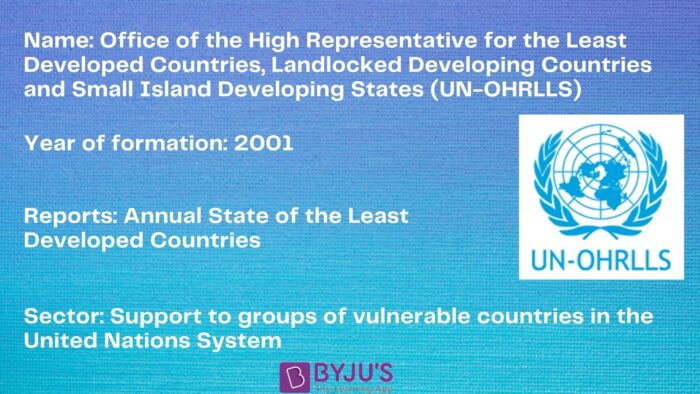The United Nations Office of the High Representative for the Least Developed Countries, Landlocked Developing Countries and Small Island Developing States, also known as, the UN-OHRLLS, is an office of the United Nations Secretariat. International organizations and UN bodies are especially important for the UPSC exam, as they feature regularly in the news.

UN-OHRLLS
UN-OHRLLS was founded by United Nations resolution 56/227 in 2001.
- Its primary function is to garner international support and advocate in favour of three vulnerable country groups by raising awareness of the environmental, social as well as economic potential existing in those countries.
- It helps the three vulnerable groups of countries address the challenges facing them in achieving sustainable development and goals that are internationally agreed.
- Besides national governments as well as their development partners, the organisation works with the support of academia, civil society, media and foundations.
To know more about Important Headquarters of International Organizations, check the linked article.
UN-OHRLLS Functions
UN-OHRLLS is involved in serving 91 vulnerable Member States of the United Nations. It deals with and advocates for the following three country groups:
- Least Developed Countries (LDCs): Represent the poverty stricken, vulnerable countries in the UN system.
- It leads coordination of the United Nations System and other stakeholders in providing support for sustainable development of the Least Developed Countries.
- Landlocked Developing Countries: Owing to their remoteness and little or no access to the sea in addition to significant distance from the world markets, these countries face significant challenges.
- It enhances synergies between the 2030 Agenda for Sustainable Development and the Programme of Action for Landlocked Developing Countries.
- Small Island Developing States (SIDS): SIDS are a group of developing countries that face specific environmental, social and economic vulnerabilities or challenges. The three geographical regions in which SIDS are located are: the Caribbean, the Pacific, and the Atlantic, the Indian Ocean and the South China Sea (AIS).
- It plays a leading role in raising awareness of the special case of small island developing States at the national, regional and global levels.
Programme of Action:
- Each of the three groups of countries has a distinct Programme of Action guiding the development work of countries, states, their partners, UN-OHRLLS and other stakeholders.
- Once in every 10 years each Programme is reviewed and a new set of goals are set for each group for the upcoming decade.
Frequently Asked Questions on UN-OHRLLS
Q1
Who heads UN-OHRLLS?
Currently, Secretary-General Fekitamoeloa Katoa ‘Utoikamanu heads the UN-OHRLLS.
Q2
What does UN-OHRLLS do?
At United Nations Headquarters in New York, UN-OHRLLS helps facilitate group consultations for the Least Developed Countries, Landlocked Developing Countries and Small Island Developing States. It also partners to convene focused events around thematic development issues.
Q3
When was UN-OHRLLS formed?
It was formed in 2001.
UN-OHRLLS [UPSC Notes]:- Download PDF Here
Comments